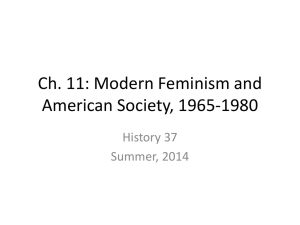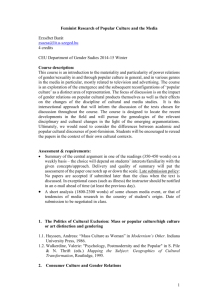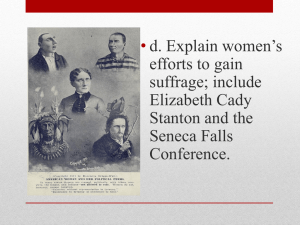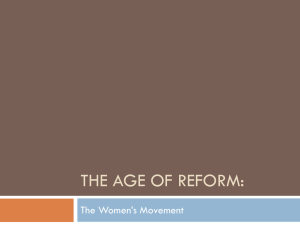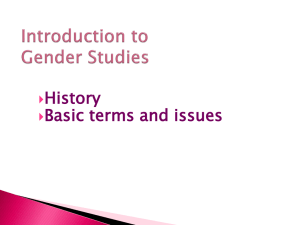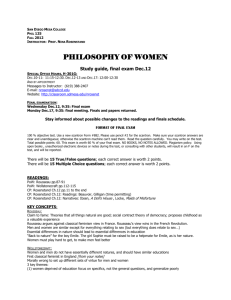Deliverable 1 – SBS 315
advertisement
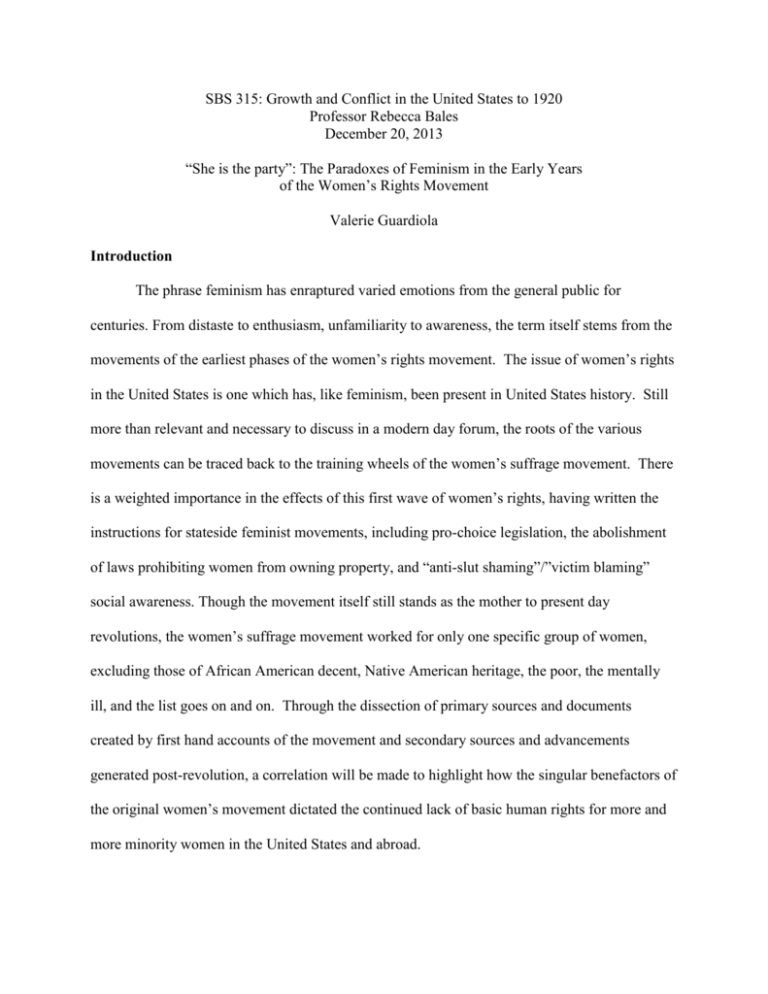
SBS 315: Growth and Conflict in the United States to 1920 Professor Rebecca Bales December 20, 2013 “She is the party”: The Paradoxes of Feminism in the Early Years of the Women’s Rights Movement Valerie Guardiola Introduction The phrase feminism has enraptured varied emotions from the general public for centuries. From distaste to enthusiasm, unfamiliarity to awareness, the term itself stems from the movements of the earliest phases of the women’s rights movement. The issue of women’s rights in the United States is one which has, like feminism, been present in United States history. Still more than relevant and necessary to discuss in a modern day forum, the roots of the various movements can be traced back to the training wheels of the women’s suffrage movement. There is a weighted importance in the effects of this first wave of women’s rights, having written the instructions for stateside feminist movements, including pro-choice legislation, the abolishment of laws prohibiting women from owning property, and “anti-slut shaming”/”victim blaming” social awareness. Though the movement itself still stands as the mother to present day revolutions, the women’s suffrage movement worked for only one specific group of women, excluding those of African American decent, Native American heritage, the poor, the mentally ill, and the list goes on and on. Through the dissection of primary sources and documents created by first hand accounts of the movement and secondary sources and advancements generated post-revolution, a correlation will be made to highlight how the singular benefactors of the original women’s movement dictated the continued lack of basic human rights for more and more minority women in the United States and abroad. The realm of the feminist includes, at minimum, three or four phases of women’s rights: the early phases founded by Elizabeth Cady Stanton, Susan B. Anthony, Ida B. Wells and the thousands of women who fought along side them knowing their years would not see the end of their fight, a calmer generation led by Carrie Chapman Catt and Anna Howard Shaw, the politically explicit balancing acts of the post 1910 movements founded by Lucy Burns and Alice Paul, and the modern day, “women’s rights are equal rights” movements that students, parents grandparents and more and more are becoming aware of. Regardless of any of these movements motives to create a more equal playing field for all, they also held flaws which, unfortunately, would follow them generation through generation. It should be the goal of this latest movement to do what all attempted, but none succeeded at – the inclusion of all privileges, races, genders, sexualities, etc., into the outlining of its freedoms. This importance lies heavily in Elizabeth Cady Stanton’s address to the Committee of the Judiciary of the United States Congress in 1892, ten years before her death. Stanton was rightfully critical of the patriarchal fashion of the United States, and at the end of her address stated: Our inner being, which we call ourself, no eye nor touch of man or angel has ever pierced…for to it only omniscience is permitted to enter. Such is individual life. Who, I ask you, can take, dare take, on himself the rights, the duties, the responsibilities of another human soul?1 Elizabeth Cady Stanton, “Solitude of Self” (speech presented to Committee of the Judiciary of the US Congress, Washington, January 18, 1892). 1 This is the feminism that one must look upon in regards to dissecting the history of the women’s rights movement and calling out the inadequacies which the founding mother’s disregarded in terms of race and acceptance. The Feminist Critique Many twentieth century academics on feminist theory and history can tend to miss the exclusionary tactics of their predecessors, citing a necessity in other demands among white women. Such historians and authors draw from dynamics in nineteenth century women’s movements that focus on the evolution of women’s suffrage through the focus on white demographics. Nancy Cott employs such tactics and acknowledges the counter dynamics of the earliest movements, as it "revealed paradoxes which had hovered around efforts to obtain women's rights earlier but which had become defining elements of feminism in the twentieth century”.2 Ultimately this highlights the, either moral or social, inability of early women activists to acknowledge the citizenship of minority women. Similar inadequacies are highlighted in One Woman, One Vote: Rediscovering the Woman Suffrage Movement, an anthology which actually includes pieces of Cott’s as well as of others. The works mention insufficiencies in who is considered a woman and who would be covered in any legislation following the women’s movement, as though minorities were “victims of both racism and sexism and eager to fight against both” African American women were excluded from both movements and not considered for either of the suffrage movements.3 2 Nancy Cott, The Grounding of Modern Feminism. (Yale University Press, 1987), 6. Marjorie Spruill Wheeler, One Woman, One Vote: Rediscovering the Woman Suffrage Movement (Troutdale: New Sage Press, 1995), 136. 3 Though the mothers of this revolution, Susan B. Anthony and Elizabeth Cady Stanton, were not against capturing the vote for women of any race, there remained conflict in granting suffrage to one group without acknowledging the other, even up to the fortieth anniversary of Seneca Falls. Louise Michele Newman mentions just this in her book White Women’s Rights: The Racial Origins of Feminism in the United States. Newman explains there were “mixed feelings about the way in which woman’s rights had become subordinated to civil rights in this ear”, and such frustrations were illustrated in Anthony and Stanton’s working relationships with prominent African American leaders such as Frederick Douglass, Robert Purvis and Ida B. Wells.4 The two earliest phases of the movement, between 1870 and 1920, obviously included movement of great achievement, as the nineteenth amendment was passed at the tail end of this era, but “despite moments of interracial cooperation, the women’s movement remained largely segregated” and included incidents where African American suffragists were denied participation within organizations such as the National Women’s Party and the National American Woman Suffrage Association.5 The categorization of white suffragists as racist is not one which comes without circumstance, as Newman explains “the gathering force of the woman [suffrage] movement had by the early twentieth century encouraged into voice women who spoke out…about disenfranchisement explicitly informed by racial, political or economic loyalties”.6 But it did not necessarily embrace the differences it spoke out regarding. Alice Paul was, perhaps, the primary player of this discourse, creating an atmosphere that was suspect of racism and not necessarily in Louise Michele Newman, White Women’s Rights: The Racial Origins of Feminism in the United States (New York: Oxford University Press, 1999), 3. 5 Newman, White Women’s Rights: The Racial Origins of Feminism in the United States, 6. 6 Newman, White Women’s Rights: The Racial Origins of Feminism in the United States,17-18. 4 the way of the feminism that Anthony and Stanton dedicated their lives to. An incident signifying this occurred when Paul asked African American suffragists to participate in events separately from her women’s party, a concept that infuriated Ida B. Wells to such an extent that she repeatedly snuck in to the events. A Progressive Leap After the death of Elizabeth Cady Stanton and the soon after passing of Susan B. Anthony it was time for the second generation of suffragists to take the reigns. At the head of that carriage sat Anna Howard Shaw and Carrie Chapman Catt, two individuals who helped to wrangle hundreds of women, and some men, into the movement under the Stanton/Anthony presidency. Shaw believed that “nothing bigger can come to a human being than to love a great cause more than life itself”, a sentiment, perhaps, passed down from her predecessors.7 Shaw, along with Carrie Chapman Catt, were of the same time as Alice Paul and Lucy Burns, but not at all of the same movement tactics. Catt and Shaw’s feminism was one that recognized the necessity to stay within a friendly hand of the President, as this could translate to a friendly relationship with Congress when and if the need arose. In a speech give four years before her death, Shaw explained that “either a Republic is a desirable form of government, or else it is not” and if it was then it should be open to regarding all genders as citizens.8 What Shaw failed to mention, as is what most of the movement fails to recognize, is that the government has a necessity, and an obligation to “National Women’s Hall of Fame” (last updated 2011) http://www.greatwomen.org/women-ofthe-hall/search-the-hall/details/2/140-Shaw 8 Anna Howard Shaw “The Fundamental Principle of a Republic (speech presented at New York Stet Equal Suffrage Campaign, New York, June 21, 1915). 7 regarding all races, creeds and genders as citizens. In the years after Shaw’s term as influencer of the female gender, issues of racial discrimination and inadequacies in logistics continued, and with the beginning of a new, radical line of feminism introduced by Paul and Burns, there became hope for a more open women’s movement – unfortunately that was not the case. The introduction of Alice Paul and Lucy Burns to the feminist scene in 1913 was the start of a new feminist movement, one which was energized, young and hell-bent on achieving more than the vote for women in the United States. Standing as one of the most important, critical and controversial actions in women’s history, the march in the Capitol the day prior to President Wilson’s inauguration highlighted the “enthusiasms and… intense determination” of the young party, though it also “diverged so far from the path of NAWSA” to an extent that in a year the Congressional committee led by Paul was completely independent from the previous women’s parties.9 This serves as a glaring contrast to the origins of the movement that came at a “point which abolitionism led ‘nominally free’ women (to use Angelina Grimke’s words) to recognize and protest their own kind of enslavement”.10 As Cott notes “tradition of political action and argumentation laid down by the woman movement was crucial to Feminism's coherence in the 1910s; the contemporary suffrage and labor movements and experiments in radical art and politics supplied the soil in which it grew like an organism".11 This new emphasis on feminism was crucial and 1910 played an even heavier role, as it ended a phase of historical revolution that was coined as “’the doldrums’ of the woman suffrage movement” and was seen as merely “training grounds for many Progressive 9 Cott, The Grounding of Modern Feminism, 54. Ellen Carol DuBois, Woman Suffrage and Women’s Rights (New York: New York University Press, 1998), 8. 11 Cott, The Grounding of Modern Feminism, 50. 10 activists”.12 The rejuvenation of the feminism movement and the fight for women’s suffrage was necessary, and is credited to being the push that was necessary to the historical 19th Amendment, ratified in 1920. Even though the ratification of the 19th Amendment proved to be one which changed the course of history for women, it was, at that point in time, only encompassing of women of white and black race. But this point would prove mute, as “within a decade, state laws and vigilante practices effectively disenfranchised most black women in the South”.13 The social repossession of Constitutional rights for African American women after the ratification of the amendment somewhat proves Newman’s claim that “citizenship in [the United States] was (and still is) racialized and gendered at its core”.14 Even before the amendment might have well have been revoked for African American women, the 19th Amendment never even touched women of Native American decent – not to mention the complete and blatant disregard of native peoples in the entirety of the execution of the Constitution. It was not until 1924 that Native Americans were granted the vote – with undoubtedly long years in between in regards to Native American women. Modern Day Fairy Tale Despite the rhetoric surrounding all phases of the feminist, the political measures taken by the major players in the women’s movement were those which granted access to resources for white women everywhere, but still have a large obstacle to face in doing the same for all women regardless of nationality or race. As Cott states in her piece included in Wheeler’s anthology, 12 Wheeler, One Woman, One Vote: Rediscovering the Woman Suffrage Movement, 14 & 176. “National Women’s History Museum”, last modified 2007. http://www.nwhm.org/onlineexhibits/rightsforwomen/AfricanAmericanwomen.html. 14 Newman, White Women’s Rights: The Racial Origins of Feminism in the United States, 19. 13 activists such as Alice Paul, Lucy Burns, and other members of the National Woman’s Party "would take up the term Feminism and become the prime mover in giving it a political and organizational dimension once the ballot was gained."15 Perhaps early movements such as this, and the circulation of the term itself, were what created the greatest danger to the movement itself – the fear of the language surrounding women’s rights. Feminist mother Elizabeth Cady Stanton perhaps said it best, in a lyceum lecture she performed in 1869, far before the modern day feminist movements which, not only asked for equal treatment for women, but universal equality for any human, If we would train our sons more in what are called the feminine virtues and accomplishments, and our daughters more in the healthy outdoor exercise and the masculine virtues of self-control and self-dependence, they would be equally improved and happier for the imitation of what is best in each other.16 The movements of the past are crucial to the knowledge and power that can be gained by the movements of today. Without the suffragist dedication which came from the early years of Stanton, Wells and Anthony there is no guarantee that women would be in Congress and nearing a run for the Presidential seat. Had Burns and Paul not given periods of their freedom to marching on the Capitol who could say that the freedom to live separately from a male partner could be possible for this generation and the generations to come. This is not to say though, that the efforts in the years prior to the pro-choice and equal pay revolutions one sees today were not flawed in their execution and did not hold 15 Cott, The Grounding of Modern Feminism, 53. Elizabeth Cady Stanton “Our Boys” (speech presented at Boston Lyceum Bureau, Boston, November 14, 1869). 16 themselves separate from the unequal nature of social terms. There remains, under certain circumstances, cultural occurrences within the United States that make one question whether we are actually far from the racially divided feminism of the postsuffrage years. Ultimately, “the impact of abolitionism on the history of American feminism” is one that plays into every aspect of feminism.17 As Ellen Carol DuBois explains, the greatest myth of feminism that holds the necessity to be unbound is that “political equality [is] a ‘single issue’ that ignored all the other dimensions – sexual, economic – of women’s emancipation” when in reality it is an all encompassing aspect which, when put into play properly, embodies a reality which one should fight for.18 17 18 DuBois, Woman Suffrage and Women’s Rights, 8. DuBois, Woman Suffrage and Women’s Rights, 9. Bibliography Anna Howard Shaw “The Fundamental Principle of a Republic (speech presented at New York Stet Equal Suffrage Campaign, New York, June 21, 1915). Elizabeth Cady Stanton “Our Boys” (speech presented at Boston Lyceum Bureau, Boston, November 14, 1869). Elizabeth Cady Stanton, “Solitude of Self” (speech presented to Committee of the Judiciary of the US Congress, Washington, January 18, 1892). Ellen Carol DuBois, Woman Suffrage and Women’s Rights (New York: New York University Press, 1998). Louise Michele Newman, White Women’s Rights: The Racial Origins of Feminism in the United States (New York: Oxford University Press, 1999). Marjorie Spruill Wheeler, One Woman, One Vote: Rediscovering the Woman Suffrage Movement (Troutdale: New Sage Press, 1995). Nancy Cott, The Grounding of Modern Feminism. (Yale University Press, 1987). “National Women’s Hall of Fame” (last updated 2011) http://www.greatwomen.org/women-ofthe-hall/search-the-hall/details/2/140-Shaw “National Women’s History Museum”, last modified 2007. http://www.nwhm.org/onlineexhibits/rightsforwomen/AfricanAmericanwomen.html


